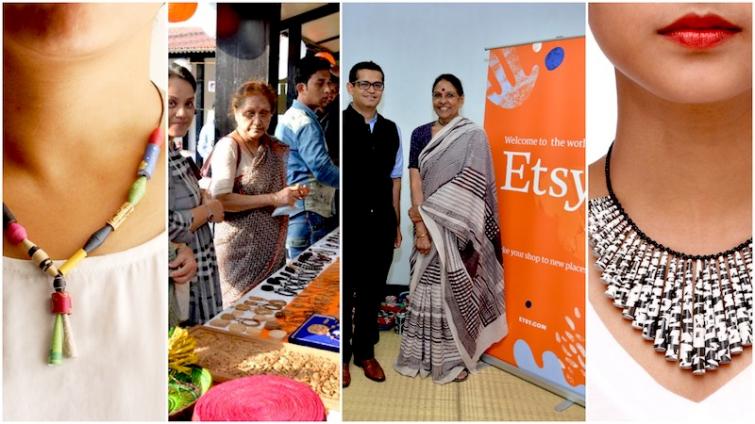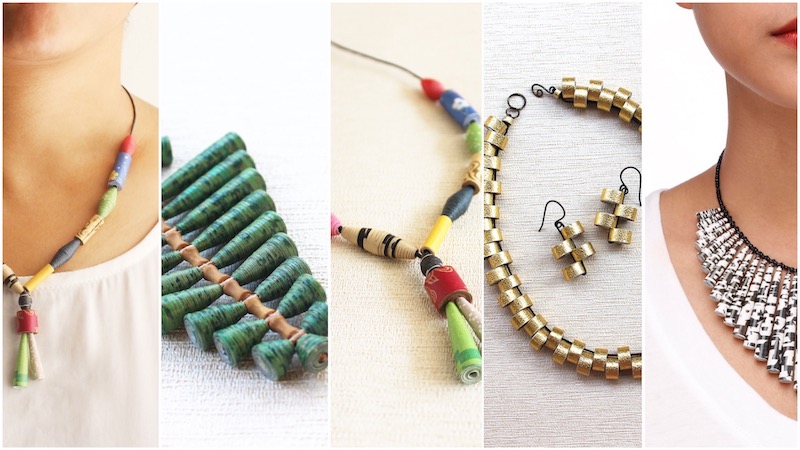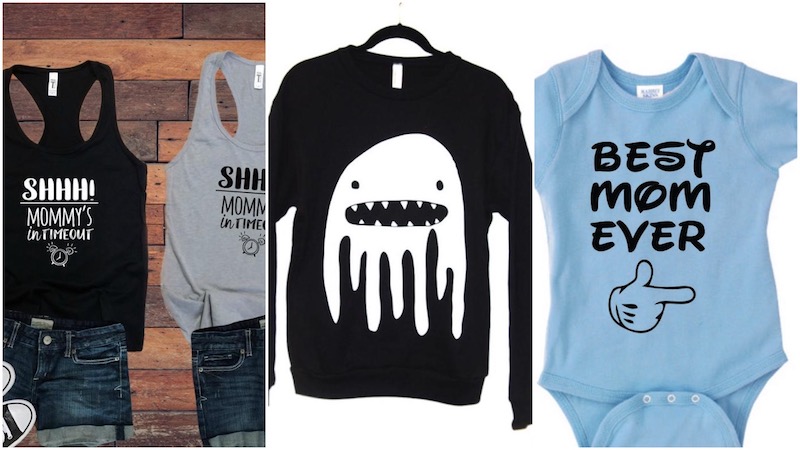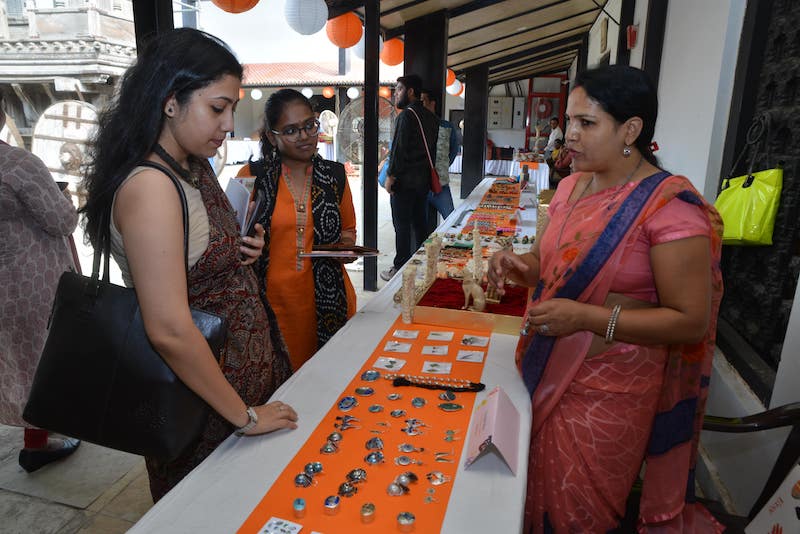
Creative women worldwide take it easy with Etsy
As the sun rises over Kolkata, India, Agnika Banerjee settles behind a desk in the corner of her room, preparing for 8 to 10 hours of crafting delicate and detailed miniatures. Nine hours later, as daylight warms the Midwestern plains in Columbia, Missouri, Melissa Tipton gets ready to mold polymer clay into tiny versions of colorful foods.
These two women on opposite sides of the world are turning creative passions into profitable enterprises by selling their handmade treasures through the international online marketplace Etsy. Sites like these are empowering women around the world, giving them new ways to support themselves and their families and exposing customers to handmade goods from a myriad of cultures.
“My first order on Etsy was from California,” Banerjee said. “An international order made me feel that I had arrived as a business person.”
Etsy and similar sites are opening up new opportunities for female entrepreneurs while boosting women’s workforce participation and economic fortunes.
Women currently account for 39 percent of the workforce globally and 46 percent in the United States, according to the World Bank. The rate is 22 percent in India, where 81 percent of working women are self-employed.
Etsy sees the potential for growth in the South Asian nation, and is actively working to spread awareness of the site to Indian business owners who could use it. Teaching sellers how to use the platform and optimize their digital space aims to attract more sellers..
In India and elsewhere, access to business opportunities can change lives. A branch of the United Nations called UN Women put it this way: “Women’s economic empowerment is central to realizing women’s rights and gender equality.”
Self-made, self-trained
At age 27, Banerjee was working in the human resources department at a project management company in Kolkata, feeling drained by a job she said was “mechanical and lacked creativity.”
After investing in a masters degree and gaining work experience, Banerjee wasn’t satisfied with her career path. She began putting together a business plan that she said covered all the bases — “the name, the product design and range, the inventory and the government regulations.”.
Like many Etsy sellers, Banerjee is a self-taught businesswoman. The online platform allowed her to enter the retail market easily.
Etsy lets people without formal business training, or those who can’t afford a brick-and-mortar shop or a booth in a marketplace, to sell their products on a much wider scale than previously possible.
Devi Chand, who lives in India’s southern metropolis of Chennai, started a store called “Papermelon” in 2009 that sells sustainable paper jewelry. She soon began showcasing her wares on Etsy. At first, she said she found the website a bit difficult to use..
But “as days passed by, the website has improved its interface, the listings have gotten a lot better and it’s a lot more user-friendly now. It has become a lot easier to figure out the operations of the website.”
Chand said Etsy is a great option for working moms like her.
“Dressing up and going to a 9-5 job isn’t a luxury I can afford, so Etsy is perfect for me,” said Chand, who has a 5-year-old. “My kid’s school hour is my working hour.”
Half a world away in Missouri, Tipton turned to library books and online courses to help her construct her business.. She test-drove ideas “to see what worked and what flopped,” she said.
“It was, and still is, a learning process,” she said. “But I found that I really enjoy the business side of things.”
As with any business, getting something off the ground takes a lot of footwork, especially when it's a one-person operation.
“In the beginning, I was working crazy hours to get things off the ground — 6 or 7 days a week, sometimes until 10 p.m.,” she said.
After eight years, she’s settled into a more reasonable schedule. But it’s still a full-time job, and her main source of income.

Branching out
Etsy, like many of the shops it hosts, is homegrown, started in a Brooklyn apartment in 2005 by three friends with a knack for crafting. Their idea — the passion project of a creative trio — has blossomed into a site with 2.1 million active sellers, according to Etsy.
From its humble New York beginnings, Etsy has made it to the big leagues, going public in 2015 with an initial public offering (IPO) of $100 million. In the company’s prospectus, the demographics of its sellers were laid out — and they were 86 percent women.
Embracing its global platform, in July 2018, Etsy expanded into places with gaps in the independent-craft market, like Germany and India. Himanshu Wardhan, the CEO of Etsy India, said India’s market had high potential for handicrafts.
“India has such a wealth of handloom and handicrafts, and what’s even more special is that every artisan has an amazing story as well,” Wardhan said. “This is very exciting for us at Etsy, with our global community of 2 million sellers. We believe that these extremely talented artisans should not lose out because of a lack of digital awareness," he added.
When the company came to India, Etsy and ‘Daastkari Haat Samiti’, which is a national association of crafts people with members from all states of India, organized a photography workshop for traditional artisans.
On this occasion the founder of ‘Daastkari Haat Samiti’, politician and promoter of Indian handicrafts Jaya Jaitly lauded what Etsy is doing.
“We are happy for Etsy’s help in pursuing a process of empowering crafts people to handle online promotion and marketing,” she said.
“Karigars (craftsmen) have skill and even design awareness now, but need assistance in coping with presentation in a digital world. Skills in photography will be a good tool for that.”
Online shopping and independent retailers
Etsy has something that conglomerates like Amazon lack — a stock of handcrafted, vintage and sometimes personalized items sold by independent retailers all over the world.
Customers on the site seek out “goods that are unique and that reflect their personality and style, not simply mass-produced, generic goods,” as described by Etsy. The selection ranges fro eccentric doughnut earrings, natural lotions and potions and knitted cat coasters.
Selling handcrafted goods targets a specific audience, one that is looking for an emotional connection with the items they buy. In the age of conglomerates like Amazon and Walmart, Etsy offers a convenient but different alternative.
Ruchi Pugalia, founder of the shop “Comfy Mummy” in Hyderabad, India, sells T-shirts, shirts, pullovers designed especially for mothers and kids. Pugalia first started selling on the website in 2012.
“Monday morning is never a drag,” she said, “because I love what I get to do for a living!”
Pugalia started her Etsy work at home.

“Then as the work expanded--we were a small team--our work moved to a small space very close to home, to what we lovingly call our 'workshop,’” she said. “My business has grown over the years. Like any business, it had its ups and downs, but I am very happy with how it has turned out.”
She said it’s “so special” to be able to share her art with the world.
Buyers and Revenue:
When asked about her buyers, Devi Chand says her buyers are mostly from abroad. "As the INR (Indian Rupee) was not one of the listed currencies when I started out, my buyers were all from abroad, the only payment option was through PayPal and until recently PayPal did not accept Indian currency.”
Chand says, “Etsy is a good place to build your career as a handicraft sellers, but no one should completely depend on an external revenue chain, as they might change their policies or the fact that when it comes to Indian sellers, they are left behind because of the shipment delays and availability.”
“A seller from the U.S. will obviously have an upper hand when it comes to selling on Etsy, because if a buyer from U.S sees my shop and a shop of a woman in the States, he/she will prefer the local seller because they might think that international shipping is a problem. Although it’s not but usually the buyer gets biased,” she adds.
Chand, however, regrets that "people are not aware of it as much as they should be and hence Etsy should conducts workshops for women all over India so that they know that their crafts can be sold from home without having to set up a shop at any fair or market." "But nonetheless it’s a great platform.”
Pugalia on the other hand believes that, those who seek, find them and Etsy has done an incredible job with their customers and sellers. Sellers get to showcase their art to the entire world, and she says, “This is the reason why it is so special.”
When asked about the growth of her business, Pugalia says, “My business has grown over the years, like any business it had its ups and downs but I am very happy with how it has turned out.”
Start Your Own Etsy Shop
Do you sketch your favorite local pubs? Knit replicas of iconic celebrities? Make your own handmade candles?
You may want to consider starting your own Etsy shop.
“Opening an Etsy shop is relatively straightforward and can provide for an optimal home for your products,” the company says.
Etsy.com is an e-commerce website that focuses on handmade or re-purposed items.
For only 20 cents, a seller can start his or her own listing on the Etsy marketplace. This allows the 19.8 million Etsy buyers to view and potentially purchase those handmade or repurposed items, according to the Etsy website.
There are a few key steps to maintaining a successful Etsy shop.
First, set small and attainable goals.
“Rather than creating task lists based on long-term goals, identify small milestones that would lead [a seller] a manageable, sane way,” Etsy says.
Secondly, invest in photography that displays products in the best light possible.
“Taking photos that are sharp, simple and illustrative is key to selling success,” Etsy says.
Finally, think of an Etsy store as a brick-and-mortar shop instead of an online database. That makes the shop feel more thoughtfully designed.
“Offer a selection of products that look like they belong together,” Etsy says. “Sell items at a variety of price points to appeal to a variety of shoppers, encourage multiple purchases and attract repeat customers.”
(This story is part of a series of special reports on India and the U.S. undertaken by the University of Missouri Journalism students. It was overseen by Laura Ungar, Midwest Editor/Correspondent with the St. Louis bureau of Kaiser Health News, and journalist Sujoy Dhar, founder of the Indian news agency India Blooms News Service.)
Support Our Journalism
We cannot do without you.. your contribution supports unbiased journalism
IBNS is not driven by any ism- not wokeism, not racism, not skewed secularism, not hyper right-wing or left liberal ideals, nor by any hardline religious beliefs or hyper nationalism. We want to serve you good old objective news, as they are. We do not judge or preach. We let people decide for themselves. We only try to present factual and well-sourced news.






.JPG)


